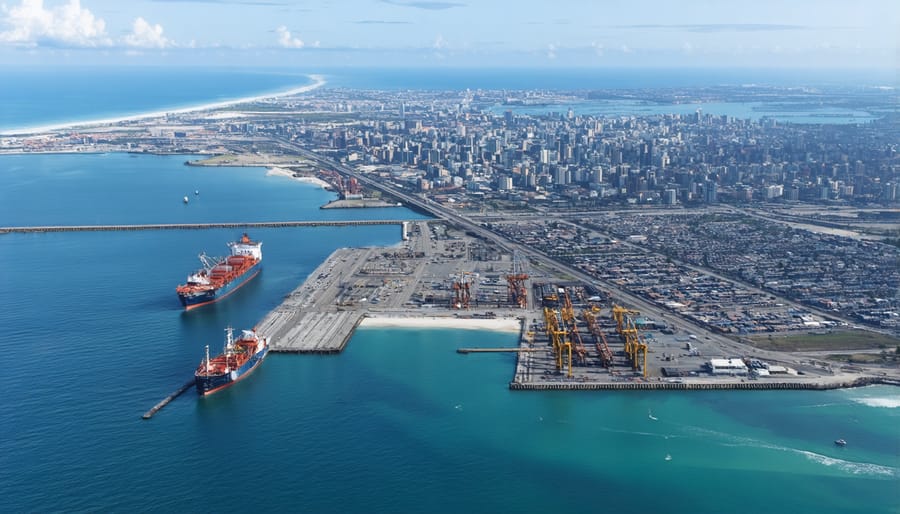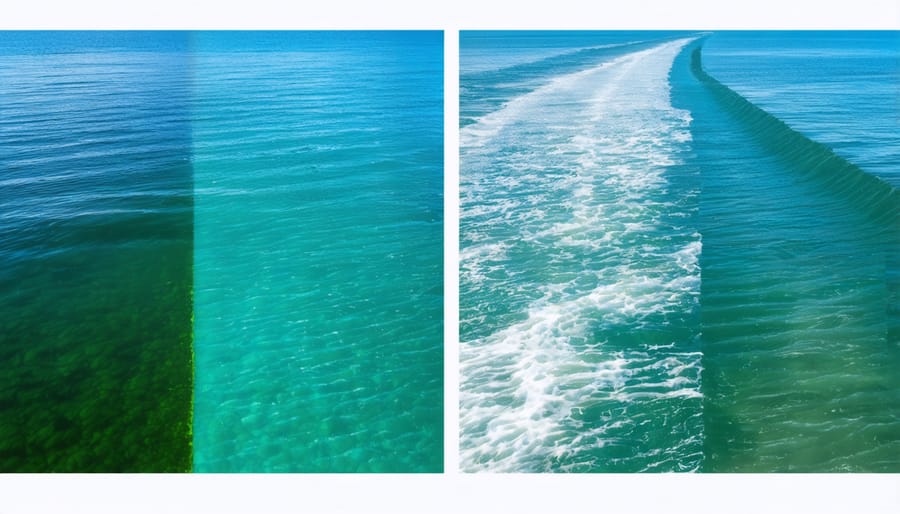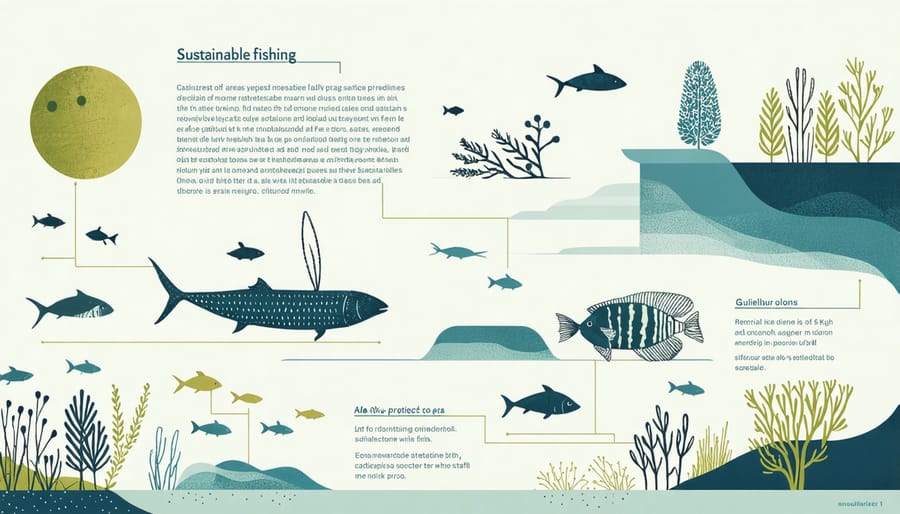
Human activities have fundamentally transformed our planet’s ecosystems, leaving an indelible mark on both terrestrial and marine environments. From the bustling coastal metropolises to remote arctic regions, anthropogenic activities – human-induced changes to natural systems – continue to reshape Earth’s delicate balance. Our footprint extends far beyond visible pollution, encompassing complex interactions between industrial development, urbanization, and resource exploitation that affect everything from microscopic marine organisms to global climate patterns.
As marine biologists and environmental scientists document unprecedented changes in our oceans, understanding these human-driven impacts becomes increasingly crucial. The scope of anthropogenic activities ranges from direct physical alterations, such as coastal development and fishing practices, to indirect effects like ocean acidification and rising sea temperatures. These changes not only threaten marine biodiversity but also impact the millions of people who depend on healthy ocean ecosystems for their livelihoods and sustenance.
Yet, within this challenge lies an opportunity for transformation. By identifying and understanding the full spectrum of human impacts on natural systems, we can develop targeted solutions and more sustainable practices. This exploration of anthropogenic activities serves as both a warning and a call to action, highlighting our responsibility to protect and preserve the natural world for future generations.
Coastal Development and Urban Expansion

Port Construction and Shipping Channels
The construction of ports and shipping channels represents one of the most significant anthropogenic modifications to coastal environments. These large-scale infrastructure projects, while essential for global commerce, often require extensive dredging, land reclamation, and shoreline alterations that can dramatically impact marine ecosystems. Through integrated coastal management, many regions are now working to balance development needs with environmental protection.
The immediate effects of port construction include the removal of natural habitats, increased water turbidity, and changes in local hydrodynamics. Dredging activities can release accumulated pollutants from seafloor sediments and disturb marine communities that have established themselves over decades. Additionally, the creation of deeper channels often alters natural water flow patterns, affecting everything from sediment distribution to larval dispersal of marine species.
Shipping channels, particularly in estuarine environments, can accelerate coastal erosion and modify natural tidal patterns. These changes can lead to the loss of critical nursery habitats for fish and invertebrates, while also increasing the vulnerability of coastal areas to storm damage and sea-level rise. However, innovative design approaches and environmental monitoring programs are helping to minimize these impacts while maintaining essential maritime infrastructure.
Coastal Tourism Development
Coastal tourism development has emerged as a significant driver of marine habitat modification worldwide. The construction of beachfront hotels, resorts, and recreational facilities often requires extensive shoreline alterations, including the clearing of mangrove forests and the dredging of coral reefs. These developments frequently lead to increased sedimentation, which can smother coral polyps and reduce water clarity essential for marine photosynthesis.
Tourism infrastructure also generates substantial wastewater discharge, with many coastal facilities releasing partially treated or untreated sewage directly into marine waters. This nutrient loading can trigger algal blooms and disrupt local ecosystem balance. The development of marinas and ports for recreational boating introduces additional pressures through anchor damage, fuel spills, and increased boat traffic in sensitive areas.
Beach modification for tourist activities, such as artificial beach nourishment and shoreline hardening, can disrupt natural sediment transport patterns and nesting sites for sea turtles and shorebirds. However, sustainable tourism initiatives, including eco-certified resorts and regulated marine tourism activities, demonstrate that economic development can coexist with marine conservation when properly managed.
Industrial and Agricultural Runoff
Chemical Pollutants
Industrial chemical pollutants pose one of the most severe threats to ocean ecosystems, with devastating impacts on marine species and their habitats. Each year, thousands of tons of toxic chemicals from manufacturing processes, agricultural runoff, and urban waste find their way into our oceans, creating long-lasting environmental challenges that complicate marine life conservation efforts.
Heavy metals like mercury, lead, and cadmium accumulate in marine food chains, affecting everything from microscopic plankton to apex predators. These substances can cause developmental disorders, reproductive failures, and neurological problems in marine species. Persistent organic pollutants (POPs), including PCBs and pesticides, are particularly concerning due to their resistance to environmental degradation and ability to bioaccumulate in fatty tissues.
Industrial wastewater often contains complex chemical mixtures that can alter water chemistry, leading to ocean acidification and oxygen depletion in coastal waters. This creates “dead zones” where marine life struggles to survive. Plastic production facilities release microplastic pellets and chemical additives that further compound these issues.
The good news is that improved industrial practices, stricter regulations, and innovative treatment technologies are helping reduce chemical pollution. Many companies are now adopting cleaner production methods and implementing advanced wastewater treatment systems to protect our oceans.
Agricultural Impact
Agricultural practices, particularly the use of fertilizers and pesticides, have profound effects on marine ecosystems through a process known as agricultural runoff. When rain or irrigation water flows over farmland, it carries excess nutrients and chemical compounds into rivers, streams, and eventually the ocean.
Nitrogen and phosphorus-rich fertilizers cause devastating algal blooms in coastal waters. These blooms can deplete oxygen levels, creating “dead zones” where marine life struggles to survive. The Gulf of Mexico hosts one of the largest dead zones globally, primarily caused by agricultural runoff from the Mississippi River Basin.
Pesticides pose equally serious threats to marine biodiversity. These chemicals can persist in the environment for years, accumulating in the tissues of marine organisms and moving up the food chain. Studies have shown that pesticides affect the reproductive success of fish, damage coral reef systems, and harm essential marine species like plankton.
Marine conservationists have observed concerning trends where commonly used herbicides impact seagrass beds, which serve as crucial nursery grounds for numerous marine species. However, sustainable farming practices, such as precision agriculture and organic farming methods, are helping reduce these impacts while maintaining agricultural productivity.

Marine Resource Exploitation
Commercial Fishing
Commercial fishing practices have dramatically transformed marine ecosystems worldwide through industrial-scale harvest methods. Large commercial vessels equipped with advanced technology can locate and capture entire schools of fish, often depleting local populations faster than they can naturally recover. Bottom trawling, a particularly destructive method, involves dragging heavy nets across the seafloor, damaging vital habitats like coral reefs and seagrass beds while capturing both target species and unintended marine life.
The issue of bycatch remains one of the industry’s most pressing challenges, with an estimated 40% of global catch consisting of non-target species. This includes endangered sea turtles, dolphins, and juvenile fish vital for population recovery. Modern fishing fleets also contribute to marine pollution through lost or abandoned fishing gear, known as “ghost nets,” which continue to entangle marine life for years.
Despite these challenges, sustainable fishing initiatives are gaining momentum. These include implementing catch quotas, establishing marine protected areas, and developing more selective fishing gear. Some fishing communities have successfully adopted traditional, lower-impact methods while maintaining profitable operations, demonstrating that commercial fishing can coexist with marine conservation efforts.
Seabed Mining
Seabed mining represents one of the newest frontiers in mineral extraction, targeting valuable metals and minerals from the ocean floor. This practice involves using specialized equipment to harvest polymetallic nodules, cobalt-rich crusts, and massive sulfide deposits found in deep-sea environments. While the potential economic benefits are significant, the environmental implications are profound and largely unknown.
The extraction process disrupts delicate deep-sea ecosystems, creating sediment plumes that can suffocate filter-feeding organisms and alter the chemical composition of their habitat. These disturbances can persist for decades, affecting species that have evolved over millions of years in these stable environments. Marine biologists have observed that even small-scale experimental mining has led to significant reductions in biodiversity and ecosystem function.
Scientists estimate that many deep-sea species affected by mining activities may be yet undiscovered, making it impossible to fully assess the impact of these operations. The International Seabed Authority is working to establish regulations for sustainable seabed mining practices, but many experts advocate for a precautionary approach until we better understand these unique ecosystems and their role in ocean health.
Effective Mitigation Strategies
Policy and Regulation
International marine protection laws have evolved significantly over the past decades, establishing crucial frameworks for ocean conservation. The United Nations Convention on the Law of the Sea (UNCLOS) serves as the cornerstone of marine governance, defining territorial waters and exclusive economic zones while setting standards for marine resource management.
Regional agreements complement these global frameworks, with initiatives like the OSPAR Convention protecting the Northeast Atlantic and the Barcelona Convention safeguarding the Mediterranean. These agreements often include specific protocols addressing pollution control, habitat protection, and sustainable fishing practices.
Marine Protected Areas (MPAs) represent a key policy tool, with countries increasingly committed to protecting 30% of their waters by 2030. These protected zones vary in their level of restriction, from no-take zones to areas permitting sustainable resource use. The implementation of new marine conservation technologies has enhanced monitoring and enforcement capabilities within these protected areas.
Recent regulations have also focused on emerging threats, including plastic pollution and ocean acidification. The International Maritime Organization (IMO) has implemented stricter emissions standards for shipping, while many nations have enacted bans on single-use plastics and microbeads. These policy frameworks demonstrate a growing recognition of the need for coordinated international action to protect marine ecosystems.

Community-Based Conservation
Local communities are increasingly taking the lead in marine conservation efforts, demonstrating the power of grassroots initiatives in protecting ocean ecosystems. Through community-based ocean protection programs, residents actively participate in monitoring marine health, maintaining coastal habitats, and implementing sustainable fishing practices.
Successful examples include the Locally Managed Marine Areas (LMMAs) in the Pacific Islands, where traditional ecological knowledge combines with modern conservation techniques. These initiatives have resulted in increased fish populations, healthier coral reefs, and improved livelihoods for local communities. In the Philippines, community-led marine protected areas have shown remarkable success, with some regions reporting up to 50% increase in fish abundance within protected zones.
Volunteer programs play a crucial role in these efforts, with citizen scientists contributing to data collection, beach cleanups, and educational outreach. Marine biologists working alongside community members report higher compliance with conservation measures when local stakeholders are directly involved in decision-making processes.
These initiatives often incorporate traditional fishing practices and cultural values, creating a balanced approach to marine resource management. By empowering local communities to become stewards of their marine environments, these programs ensure long-term sustainability while preserving cultural heritage and providing economic benefits through eco-tourism and sustainable fishing practices.
The impact of anthropogenic activities on marine ecosystems is undeniable, but our collective efforts can make a significant difference in protecting our oceans. Through this exploration of human activities affecting marine environments, we’ve seen how industrial practices, coastal development, pollution, and resource exploitation continue to threaten marine biodiversity. However, we’ve also discovered numerous successful conservation initiatives and technological innovations that offer hope for the future.
Each of us has the power to contribute to marine conservation efforts. Whether through supporting sustainable fishing practices, reducing plastic consumption, participating in beach cleanups, or advocating for stronger environmental policies, individual actions create rippling effects across our ocean ecosystems. Marine scientists and conservationists worldwide are making remarkable progress in habitat restoration and species protection, but they need public support and engagement to expand their impact.
Consider joining local conservation groups, supporting marine research organizations, or educating others about the importance of ocean preservation. By working together and making informed choices in our daily lives, we can help ensure the survival and recovery of marine ecosystems for future generations. The time to act is now – our oceans’ future depends on the choices we make today.
jessica
Ava Singh is an environmental writer and marine sustainability advocate with a deep commitment to protecting the world's oceans and coastal communities. With a background in environmental policy and a passion for storytelling, Ava brings complex topics to life through clear, engaging content that educates and empowers readers. At the Marine Biodiversity & Sustainability Learning Center, Ava focuses on sharing impactful stories about community engagement, policy innovations, and conservation strategies. Her writing bridges the gap between science and the public, encouraging people to take part in preserving marine biodiversity. When she’s not writing, Ava collaborates with local initiatives to promote eco-conscious living and sustainable development, ensuring her work makes a difference both on the page and in the real world.
